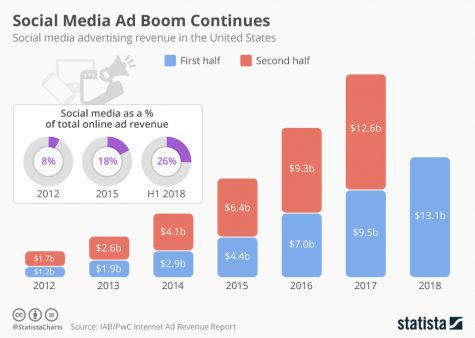The Echo Chamber
January 6, 2020
Social media, the cornerstone of modern life. These platforms allow people to communicate anything, no matter their opinion or view on the world, and then the platforms lock-in that view.
The fact that social media caters content to your liking is no secret. This has created something commonly known as the ‘echo chamber effect.’
An echo chamber is created by the constant use of social media and exposing those platforms to opinions. The platform will examine this by tracking what you like, what you spend the most amount of time watching, and what you search on it. This creates a loop of information and only shows what the user likely wants to see, and an often unnoticed supporter of these methods are social media “bots.”
So what are these “bots”? Bots are digital robots that are programmed to promote a single cause or item until told to stop. These constantly fill space in the discussion of politics, and users are likely to have seen bots while browsing social media.
Twitter, while not as direct as other platforms, can still feel as if it is one huge echo chamber. 80% of Twitter’s content is from US-based users and the content itself tends to be highly political. This effect is amplified by bots on the site. Bots occupy 5-10% of all accounts on the platform but produce 20-25% of all of the content on it. The activity of many of the bots on Twitter has a reputation for being highly political. Bots can also be easy to find. Twitter has a “For You” page with news and trends that the user is likely interested in, based on information they have gathered about the user. Then this user may see an account they like and, like the post or follow the account, which will keep Twitter sending the user media with similar views and opinions, surrounding the user with what they want to hear.
Bots also hold a presence on YouTube and Instagram but do not always have as much political presence. YouTube bots are often “scam bots.” These are bots that mimic people that have a following on the platform and post comments with links in them. These links will often lead to a website that will take your information. Bots on Instagram are often marketing bots. These include placing comments that promote a person or brand on an unrelated post or having bots follow someone’s account to make it seem as if they are more well-known. In theory, these bots are used to boost a creator or company’s presence. If the user likes the post or views the account posting the ad, they will receive ad posts similar to the initial post.

So what are media companies gaining from, intentionally or unintentionally, creating echo chambers? The reason behind this is quite simple: social media companies gain revenue through ads on their sites. The best way to have users view more ads is to keep them on the site for as long as possible. What better way to do that than show users what they want to see? The longer a user is on the website, the more ads will be shown, and the website will profit.
Changing these functions in social media can have a huge impact on the platforms themselves. On some platforms, users have the ability to deactivate targeted ads and posts. Removing these could lower traffic and possibly lower revenue generated by websites, but could also give social media companies more positive PR which would attract more users.
This wouldn’t remove the chance of echo chambers, but it would decrease the chance of a user falling into one.












